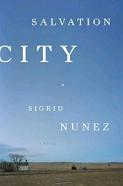by Nika Knight
Sigrid Nunez’s sixth and latest novel takes place in a bleak near future, in an America struggling to recover in the devastating aftermath of an international flu pandemic reminiscent of 1918. Unlike those most prevalent recent imaginings of post-apocalyptic America, The Road and The Hunger Games, Nunez’s novel doesn’t take place in a dystopic wasteland — the world the protagonist, Cole Vining, moves through is one much like our own. The 13-year-old son of two unhappily married, upper middle-class intellectuals, Cole is orphaned by the flu shortly after the family’s move from Chicago to a small college town in Indiana. After brief, delirious stints in an overwhelmed hospital and a Dickensian orphanage, he’s adopted by a pair of fundamentalist Christians in the newly renamed Salvation City, Indiana.
Sheltered by the small town’s spiritual leader, Pastor Wyatt (or “PW”), Cole begins to navigate one of the novel’s key preoccupations: the tensions between faith versus reason, religion versus intellectualism, red state versus blue. And it’s on this level that the novel falters: Cole’s parents, those beacons of a coldly intellectual, left-wing and coastal lifestyle, are unsympathetic, flat characters. PW and the rest of Salvation City, on the other hand, provide a warm, charismatic and, overall, more human alternative.
What Nunez often seems to have set out to do in her scenes in Salvation City is to create a human portrait of the “other side” — a side comprised of those who crusade against evolution in textbooks, stand vigilant outside abortion clinics and await, rapturously, for the soon-to-come Second Coming. And this whole premise sits uneasily — are the lines between liberal and conservative, Democrats and Republicans, atheist and religious in this country truly so thickly drawn that it’s a radical experiment to propose that we all might be equally human? The implied answer in Salvation City is: yes. And if that is in fact the case, well, perhaps we should all start praying.
But despite the flatness of its politics and, consequently, many of its characters, the novel partly saves itself in its portrayal of adolescence. While marketed as a dystopian novel, Salvation City is nothing of the sort (although dystopian literature and novels about teenagers do, especially lately, overlap.) Rather, Salvation City is more distinctly a meditation on adolescence, and in particular, what it is like to be thirteen. Nunez’s plot is hardly concerned with the widespread anarchy that is occasionally mentioned as a national after-effect of the flu pandemic – rather, she focuses on the internal, intensely personal processes that take place as Cole moves interminably toward the adult world.
Nunez hits her most pitch-perfect notes as she describes Cole’s inner life; those moments when Cole nonchalantly observes the inhuman social stratosphere of middle school (in Nunez’s near-future slang, hot girls are “apocalyptic,” ugly ones are “PBAs” — or partial-birth abortions), navigates embarrassing and confusing interactions with his peers and adults, and considers the weighty questions of the nature of art, family ties, truth and faith. Overall, Salvation City finds redemption in its beautifully nuanced depiction of those years in which the overarching emotional landscape is one of devastation, intensity, beauty, grief and betrayal — indicating that our own dystopia might be the one we’ve already experienced.
This post may contain affiliate links.









